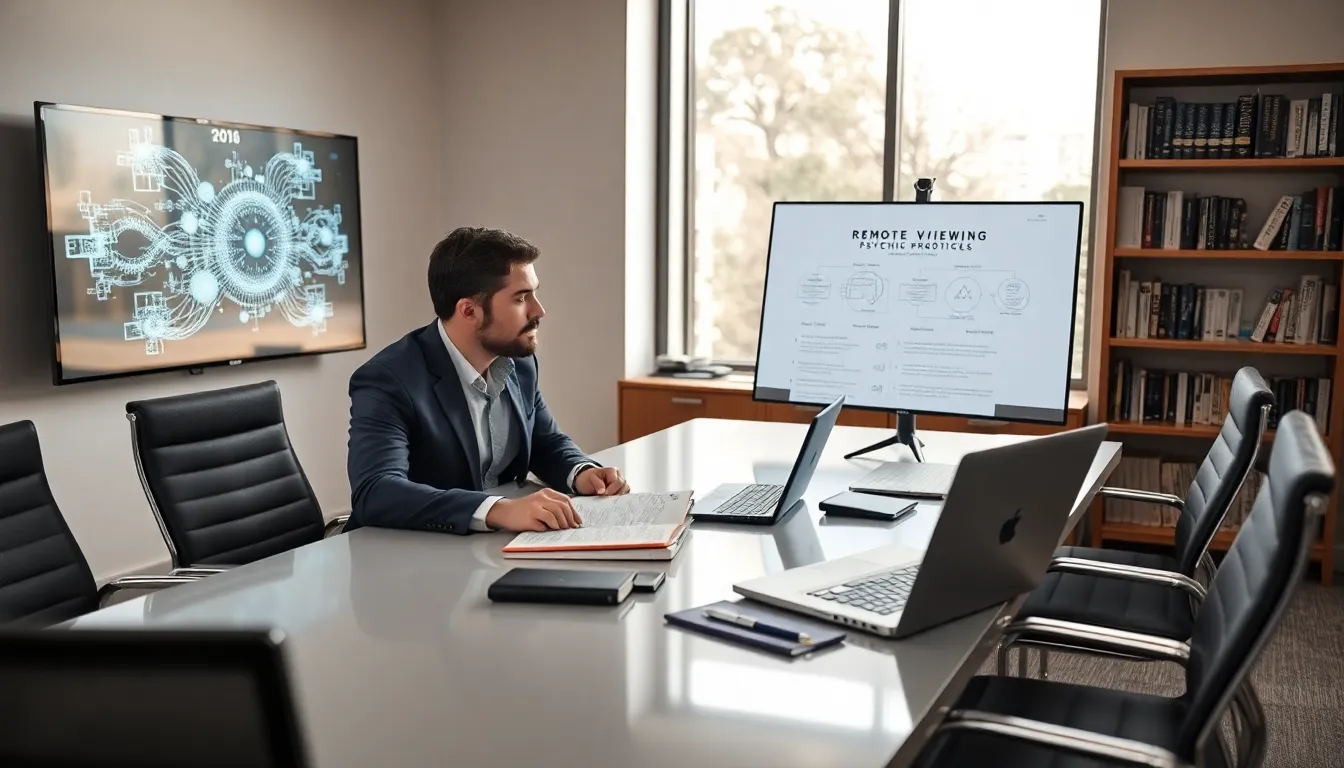Table of Contents
ToggleEver wondered if you could stretch your mind beyond the ordinary? Imagine peeking into places you’ve never been, all from the cozy confines of your armchair. Remote viewing is like having a superpower, no cape required. This intriguing practice has baffled scientists and enthusiasts alike. So, how does remote viewing work? Let’s jump into this intriguing realm where intuition meets technique.
Understanding Remote Viewing

Remote viewing, at its core, involves perceiving details or information beyond normal sensory perception. Think of it as tuning into a mental frequency that reaches objects or events across time and space. Supporters of remote viewing assert that everyone has the potential for this capability. With the right training, they believe individuals can develop a skill set akin to a hidden talent, like discovering your knack for painting after years of doodling.
This phenomenon operates under the premise that consciousness can transcend location, basically, your mind can wander as freely as a cat chasing a laser pointer. The idea here is not just about seeing things at a distance: it’s about tapping into a universal pool of information. Fascinating, right?
An essential part of understanding remote viewing is recognizing it as a structured, methodical approach. Unlike mere daydreaming or imagination, remote viewing follows a specific set of protocols designed to minimize interference from the viewer’s thoughts and biases.
History of Remote Viewing
Remote viewing isn’t a brand-new concept. Its roots can be traced back to ancient civilizations, which often dabbled in mystical practices aimed at understanding the universe. But, it gained more mainstream attention during the Cold War era when the U.S. government began exploring its military applications. Yes, folks, spies were potentially outfitted with more than just cool gadgets: they were armed with psychic exploration tools.
Programs like the Stargate Project investigated remote viewing’s potential to gather intelligence and foresee enemy movements. While many results were anecdotal, they spurred further research and created a methodology. Throughout the years, many have pursued remote viewing, both skeptics and true believers, resulting in a rich tapestry of insights and experiences.
The Mechanics of Remote Viewing
How does remote viewing actually work? It’s a bit like learning to ride a bike, the more practicing you do, the better you get. But instead of two wheels, remote viewing employs what are known as ‘psychic protocols.’
Techniques Used in Remote Viewing
Common techniques include the Utilization of coordinate systems, often using geographical coordinates as a focus point. Viewers will write down impressions without any preconceived notions, aiming to capture essential elements such as colors, shapes, and emotions related to the target. The key here is to remain as objective as possible.
The Role of the Remote Viewer
The person conducting the remote viewing, known as the viewer, plays a crucial role in determining success. A great remote viewer is like a skilled interpreter at a pas de deux: they need to channel the information accurately without letting their own biases dictate what they perceive. Commitment to discipline and practice can so elevate one’s abilities, turning a novice into a proficient remote viewer.
Applications of Remote Viewing
The applications for remote viewing might surprise you. Beyond military and espionage uses, it has potential in various fields, including business and psychology. Companies have been known to explore remote viewing for market prediction, leveraging insights on consumer behavior before trends take off.
In psychology, therapists may use remote viewing to help clients explore past traumas or emotions that hinder personal growth. Imagine accessing hidden memories and emotions, could remote viewing unlock pathways to healing? It’s an exhilarating prospect that raises fascinating questions about human consciousness and its untapped potential.
Scientific Perspectives on Remote Viewing
Scientific scrutiny of remote viewing is a mixed bag. While advocates claim success stories and anecdotal evidence, skeptics argue that these results often fall short under empirical investigation. Science values repeatability, the holy grail of experimental results. While some studies suggest positive outcomes, many researchers plead for more rigorous protocols and randomized control trials to eliminate bias and psychological effects.
The ongoing debate around the phenomenon reflects a broader struggle between science and spirituality in understanding the universe’s complexities. Could remote viewing one day find a place in scientific literature? Perhaps, but as of now, it remains a tantalizing enigma.
Challenges and Criticisms of Remote Viewing
Even though its enticing promise, remote viewing is not without its challenges. Critics emphasize the lack of solid scientific backing and easy debunking of claims made by proponents. The subjective nature of personal experiences makes empirical validation a challenging job. To complicate things further, some misrepresent remote viewing as mere guesswork or even fraud.
Controversy surrounds the methodologies employed by some practitioners. Are these protocols effective, or are they merely psychological tricks that lead participants to think they’ve tapped into something extraordinary? The skepticism surrounding remote viewing underscores the need for continued research to better understand both its capabilities and its limitations.








